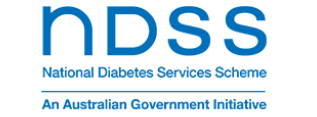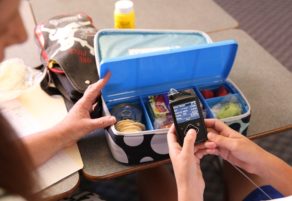Having a child with type 1 diabetes can have a significant impact on parents
It’s normal for parents to feel worried about how their child will cope when they’re at school.
School staff play an important role in supporting a child with type 1 diabetes to learn and be active while at school.
Having a good relationship with teachers and school staff is important to make this happen.
All school staff should have a basic understanding of type 1 diabetes. Designated staff who agree to have day-to-day responsibility for a student with type 1 diabetes should access additional training.
This includes training to know how to monitor glucose levels, identify low and high glucose levels and support insulin administration.
Communicating any changes to your child’s diabetes management plan to school staff will help them to stay up to date and provide the care that your child needs to manage their condition and thrive at school.

Understanding type 1 diabetes
Type 1 diabetes can occur at any age but is usually diagnosed in children and young adults.
In type 1 diabetes the pancreas loses the ability to make insulin. This means people living with type 1 diabetes need to replace their insulin to live.
It is a lifelong condition that requires a combination of daily insulin doses and regular glucose monitoring. Currently insulin can only be given by injection or an insulin pump.
Type 1 diabetes is not a lifestyle-related condition and is not contagious. It is an auto immune condition in which the body attacks the insulin producing cells in the pancreas and destroys them. Type 1 diabetes is not preventable and the cause is currently unknown.
Frequently Asked Questions
-
What is type 1 diabetes?
Type 1 diabetes affects about 10–15% of all people living with diabetes. It is usually diagnosed in younger people, but it can be diagnosed at any age.
The condition occurs where there is too much glucose (sugar) in the bloodstream. Glucose is an important source of energy for your body. It comes from carbohydrate foods that you eat, such as bread, pasta, rice, cereals, fruits, starchy vegetables, milk and yoghurt. Your body breaks down carbohydrates into glucose, which then enters your bloodstream.
Insulin is made in your body by the pancreas. Insulin is needed to allow glucose from the bloodstream to enter the body cells to be used for energy.
Type 1 diabetes occurs when the pancreas can’t produce insulin. This happens usually because the body’s immune system destroys the cells that make the insulin (beta cells).
The exact cause of type 1 diabetes is unknown. We do know that some people carry genes that make them more likely to develop type 1 diabetes. Type 1 diabetes occurs in these people when something triggers the immune system to start destroying the beta cells in the pancreas that produce insulin.
At present, type 1 diabetes cannot be prevented or cured. However, researchers are looking at environmental factors and the immune process as they work towards preventing type 1 diabetes in the future.
-
How is type 1 diabetes managed?
Type 1 diabetes is managed by replacing the insulin the body can no longer make. Insulin is given by injection or by using an insulin pump. A doctor will work with a person who has type 1 diabetes to decide on the type of insulin is needed, and will recommend how often insulin is needed.
A person with type 1 diabetes must check their blood glucose levels several times a day and inject insulin to provide for their body’s changing glucose needs.
If blood glucose levels drop below the normal level (4 mmol/l) Hypoglycaemia (a ‘hypo’) will occur. It can be caused by too much insulin; delaying a meal; not enough food or unplanned or unusual exercise. A hypo can progress to becoming severe if not treated promptly and can potentially cause irrational or confused behaviour, a seizure and possible loss of consciousness.
Hyperglycaemia (a ‘hyper’) occurs when blood glucose levels increase above the normal level. Hyperglycaemia can be caused by not enough insulin, too much food, common illness, or stress. High blood glucose levels affect learning and mood.
Managing type 1 diabetes on a day-to-day basis is important for keeping blood glucose levels in the target range. This helps a person stay well in the short term and reduces the risk of long-term complications, such as damage to the eyes, kidneys, nerves and blood vessels.
About 11,000 students in Australian schools need help to manage this condition, which impacts many aspects of their daily life.
-
What are the symptoms of type 1 diabetes?
The most common symptoms of undiagnosed type 1 diabetes include:
- being thirsty and drinking much more than usual;
- going to the toilet (to pass urine) more often;
- feeling tired and low on energy;
- unexplained weight loss;
- genital thrush;
- mood changes.
The symptoms of type 1 diabetes can develop quickly and need immediate medical attention. If type 1 diabetes is left untreated, diabetic ketoacidosis (DKA) will develop.
Diabetic ketoacidosis occurs when the body can’t use glucose for energy, and makes chemicals, called ‘ketones’ to use for energy instead. Ketones cause the blood to become too acidic. High glucose levels result in a loss of body salts and fluids. This is life-threatening and requires urgent hospital treatment. Learn the 4T’S Campaign.
-
What is the difference between type 1 and type 2 diabetes?
Type 1 diabetes can occur at any age, but is most commonly diagnosed from infancy to the late 30s. With this type of diabetes, a person’s pancreas produces no insulin. It occurs when the body’s immune system attacks and destroys the insulin-producing cells in the pancreas.
The only treatment for type 1 diabetes is insulin, which is usually injected or infused via a pump.Type 2 diabetes is by far the most common type of diabetes – in Australia over 90 per cent of people with diabetes have type 2 diabetes. Type 2 diabetes usually affects people aged over 40, however it is becoming more common among younger people. The symptoms of type 2 diabetes are not always obvious and, unlike with type 1 diabetes, they can take a long time to develop.
People with type 2 diabetes either don’t make enough insulin or don’t make insulin that the body can use properly. The cells in the body become resistant to insulin, making a greater amount of insulin necessary to keep blood glucose levels within a normal range. Eventually, the pancreas can wear out from producing extra insulin, and it may start making less and less.
Type 2 diabetes can usually be managed through diet, exercise, and self-monitoring blood glucose, at least in the first few years following diagnosis. However, type 2 diabetes is a progressive condition, and most people will need to take tablets and/or inject insulin after living with it for five to 10 years.
Managing type 1 diabetes at school
Type 1 diabetes is a chronic condition that affects how the body regulates blood glucose. It is a condition that needs decisions and actions to be made every day to keep glucose levels within a certain range.
Every day with type 1 diabetes is different. Every day, a student will need to consider how insulin, food and exercise will affect their glucose levels. It can be challenging to make so many daily decisions and act on them. Type 1 diabetes can affect a student’s health, how they feel and their ability to cope at school. Students and their families do their best to maintain glucose levels within a certain range by taking insulin every day. But this can be difficult, as food, physical activity, stress and illness all affect glucose levels.
 |
 |
 |
 |
 |
 |
 |
Supporting a student with type 1 diabetes
Schools have a responsibility to provide a supportive environment for all students with a medical condition including students with type 1 diabetes.
School staff may be required to provide additional support to help students manage their type 1 diabetes and participate in school life like their peers.
These supportive actions are called reasonable adjustments.
Schools and school staff might be required to support a student in a range of ways including:
- working with parent and carers to establish communication processes regarding a student’s day-to-day type 1 diabetes care (for example via a diary, phone calls or regular meetings);
- following a student’s diabetes management and action plan in relation to treating low and high glucose levels;
- providing a student with access to a blood glucose monitor, insulin and hypo treatment foods;
- ensuring a student has access to water (for drinking or to wash hands);
- allowing a student to eat at additional times in class or during physical activity.
- Allowing extra bathroom access;
- making special considerations during exams and tests;
- providing some necessary supervision (e.g. insulin administration, blood glucose levels and pump management) if required;
- providing consideration for privacy when checking blood glucose levels and/or injecting insulin, if requested.
Young students may require support and guidance in managing their type 1 diabetes needs.
A student’s diabetes management plan is an essential document that that will guide how schools can support students to participate fully in their school experience.
The diabetes management plan will usually be developed by the student’s diabetes treating team in collaboration with the student and family.
School training and support
Diabetes in Schools is an information and training program designed to support schools and school staff to help students to manage their type 1 diabetes while at school.
The program provides 3 levels of training for schools:
- Level 1 Introductory training is designed for all school staff and provides basic information about supporting students with type 1 diabetes while at school. The training includes three short online modules. It’s recommended all staff undertake level 1 training.
- Level 2 Intermediate training is designed for designated school staff who volunteer to be directly involved in supporting students with type 1 diabetes. Training is available via nine online modules (for all schools) or via group education workshops (in some states). Training covers type 1 diabetes and food, monitoring glucose levels, insulin, managing lows and highs, physical activity, school camps and planning for changes. Training is general and is not specific to the needs of individual students.
- Level 3 Individualised Skills Training is designed for designated school staff and focuses on the individual student’s type 1 diabetes management. This practical face-to-face training is delivered in the school by a qualified healthcare professional (where possible this will be a member of the student’s diabetes treating team). This will be available in some states from March 2020 and will be prioritised for schools with students who are newly diagnosed or who are unable to self administer insulin.
 |
 |
 |
 |
 |
 |
 |




















